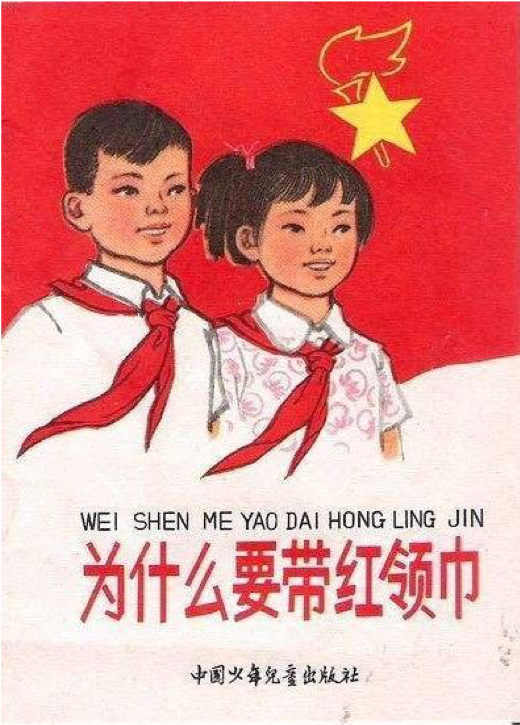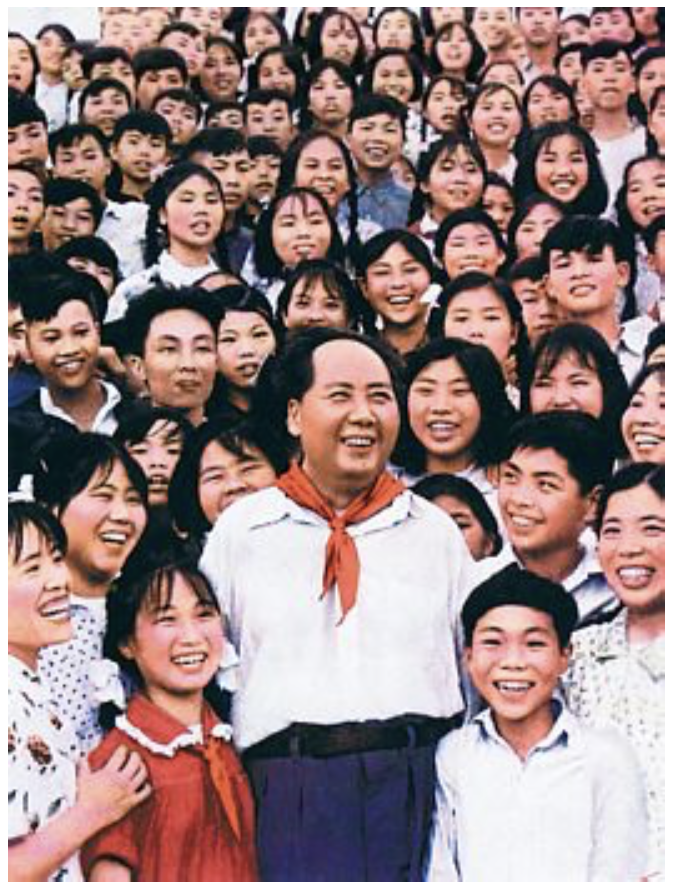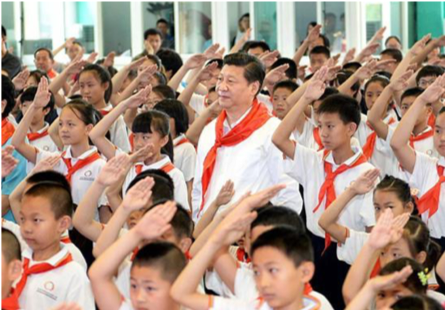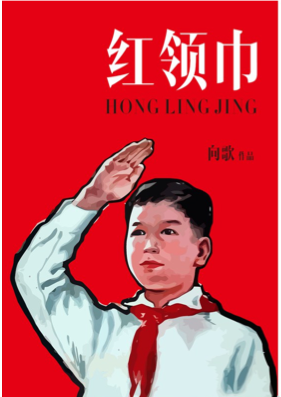The Red Scarf: Obedience, Governance, and Bureaucracy in Chinese Primary Schools
Written by Yi Li, for an assignment on ‘administrative evil’ in ANTH424, edited and published with assistance from Dr Susan Wardell.
When I was almost six, at the beginning of primary school, my teacher told me: “You are not old enough to join the Young Pioneers.” I remember feeling depressed because this meant I could not wear a red scarf (Hong Ling Jin) until the following year. It meant that I would be separated from those marked as first-class pupils.
The Red Scarf as a symbol of youth glory

Figure 1: The Book Cover of ‘Why Wear a Red Scarf?’ Published by China Children’s Press, Photo from Google Images
In China, publications for children (as per Figure 1) and political education within the schooling system, jointly construct stories about how the Chinese martyrs and heroes’ blood dyed scarves red. Once the institutional power (of political and educational structures) authorised the narrative of ‘honour’ associated with these scarves, it was taken up as a political fashion among young people. However, only the most outstanding pupils – young people aged six to fourteen – were allowed to wear the red scarves issued by the government, as part of a movement called ‘Young Pioneers of China’. Similar movements successively appeared in many Communist countries, such as North Korea and the Soviet Republic.
The motto of the Young Pioneers of China is “To fight for the cause of communism: Be ready! Always being ready!”
This reflects the socialist construction of ‘red’ emotions, such as enthusiasm and selflessness. In turn this shows how ideology informs moral values and behaviours – forming a distinctly Chinese tradition (Kleinman and Kleinman, 1985, p. 473).
This is true even for my generation, who were born in peace-time. As children, we committed to follow the notion of the Young Pioneers: to be self-disciplined, and contribute to society. In doing so we took on forms of moral behaviour that were embedded in political systems.
In this blog post I argue the ‘administrative evil’ of Young Pioneers not only produces soft violence through formal and informal rule-making and punishments, but also generates social inequality. I also argue that the process creates a ‘shadow’ in adulthood, that I reflect on as being part of the social machinery of oppression as it functions in the collective childhood of Chinese students.
Establishing the Administration: inclusion and exclusion

Figure 2: Young Pioneers Representative offered Red Scarf to Mao Zedong on 25th June 1959, in Mao’s hometown Shaoshan, Hunan province. (Photo from People.cn http://politics.people.com.cn/GB/1026/4792695.html)
In the middle of the 20th century (Figure 2), wearing a red scarf was the least privilege for very few authorised young pioneers. Two representatives (the boy and the girl next to Mao) were able to join first-class universities in Beijing once the government processed the resumption of college entrance examination in 1978. After graduation, they were expected to marry, because of this shared honour during childhood.
In contemporary primary schools (especially after the reform and opening-up policy in 1979), most pupils joined the Young Pioneers of China. To wear a red scarf on school days became everyone’s responsibility; for their class honour and individual dignity. Under the governance of senior pioneers, children’s obedience was cultivated by the ideological administration of youth glory.
Children who could not, or did not, join the young pioneers and wear red scarves became the minority among their peers (Figure 3). They would be excluded as outcasts for this. In this way, red scarves acted with authority, to include or exclude.
I vividly remember one day at school, when all my classmates shamed my desk-mate, for being the only person who had forgotten to wear the red scarf. A young ‘senior pioneer’ who was on duty deducted our class’ points, which led to us losing our status as ‘advanced’ level, in the final grade. My desk-mate was isolated by most classmates and mentors, for his accidental lapse. I remember that I remained silent, although I thought their behaviour toward him was wrong. Three months later, his father decided to transfer him to another school.
In this case, ordinary people like youth pioneers act appropriately to their organisational obligations, doing what those around them would agree they should be doing. Yet they participated in, or contributed to, what a critical and reasonable external observer might identify as morally wrong, in the distress they inflicted upon that one child.
What is administrative evil?
Social scientists Adams and Balfour (1998) deem that the technical-rational approach to social and political problems that characterises the modern age, has enabled a new and frightening form of evil. This evil is associated not with sadistic intention, but with harm caused by participation in the administration of everyday systems (Adams and Balfour, 1998, p. 13). Typically, and unlike many other forms of ethical failure, the appearance of ‘administrative evil’ is masked (Adams and Balfour, 1998). People can engage in acts of evil, unaware that they are doing so (Balfour and Alibašić, 2016).

Figure 3: Xi Jinping celebrated International Children’s Festival with Young Pioneers in Beijing Ethnicity Primary School on the 30th May 2014 (Credited by Xinhuanet, Photo from CCTV News http://news.cctv.com/2018/06/01/ARTISXoZr80oKgiYmjswGq3F180601.shtml)
As a child, I regarded the red scarf as the symbol of glory, as I was taught to do. But through this lens, as a scholar of anthropology now, I realise that it was a tool through which the children could enact and reinforce everyday systems of power, through bureaucratic systems within schools. In the harm it enacted on some children, it fits very closely with Adams and Balfour’s description of administrative evil.
Anthropologist Caton (2010, p.167) uses two philosophical concepts to unpack the idea of guilt or culpability in acts of evil: intentionality and contingency. These ideas highlight the way an anthropological analysis of evil should note the roots and contexts of actions; the role of both self-awareness (or lack thereof), and circumstance. In a similar way, Farmer (2004) proposes that anthropology of structural violence can often be understood as patterned by history, biology, and political economy (Farmer, 2004, p. 308), as well as individual ‘choice’.
Both of these views call for a holistic understanding of evil: linking macro forces to personal experience. Employing these theories is useful to examine the formation and social effect of Youth Pioneers movement, as an example of administrative power. In doing this I have also noted the rising collective nostalgia associated with red scarves, across now-adult populations.
The price of growth: collective nostalgia
In different historical contexts, both generations before and after the 1979 reform have been educated by the ideology of the red scarf – with wearing red scarves part of the recognition of excellence. When National leaders meet children who are honourees of the Young Pioneer programme, they do so knowing this glorious moment will be remembered (by the children, and others) as part of the chid’s lifelong glory.
For some individuals though, being deprived of the red scarf as a punishment has also become a part of the collective memory of a Chinese childhood.
Interestingly two different recent short films – Hong Ling Jin (2011) and The Red (2010) – both tell a story about boys were punished by confiscating their red scarves because they read cartoon books in classes. Under the punishment of the Young Pioneers, and under the institutions’ supervision, these actions cause the protagonists to fall into rebellion and self-doubt.
Both of the film’s directors were born in 1980s’ China. They described their creations as part of “nostalgia”, representing their experience in primary schools.
The social media response to these films reflects a recognition that the heart-breaking moment of losing a red scarf has formed a deeply emotional part of Chinese people’s individual and collective identity. However other aspects of public discussion on social media tends to interpret their films as the “indictment of red scarves”.
Onwards
The red scarf, a symbol accompanied by a legend about political heroes, presents a vision of glory to Chinese children. Wearing a red scarf encouraged me to embody the moral emotions of communism. However the scarf as a visible sign of being a Youth Pioneer, also became the sign of privilege, and functioned to produce obedience at an early age, via reproducing established systems of governance though bureaucratic systems. It shaped our behaviour, even to the point of our participation in emotionally harming ‘divergent’ peers.
How can a child make a moral judgement, when he/she submits to the collective? For me, the red scarf is a reminder that I, like others, I have passed through the valley of administrative evil – where no one is innocent, and no one is exempt.
References:
- Adams, G. B. and Balfour, D. L. (1998) ‘The Dynamics of Evil and Administrative Evil’, in Unmasking Administrative Evil. Thousand Oaks: SAGE Publications Ltd, pp. 2–13. doi: 10.4324/9781315716640-1.
- Balfour, D. and Alibašić, H. (2016) ‘Administrative Evil’, in Farazmand, A. (ed.) Global Encyclopedia of Public Administration, Public Policy, and Governance. Springer International Publishing, pp. 1–5. doi: 10.1007/978-3-319-31816-5_1119-1.
- Caton, S. C. (2010) ‘Abu Ghraib and the Problem of Evil’, in Ordinary Ethics : Anthropology , Language , and Action. New York: Fordham University Press, pp. 165–184. Available at: https://www.jstor.org/stable/j.ctt13x07p9.12.
- Farmer, P. (2004) ‘Sidney W. Mintz Lecture for 2001: An anthropology of structural violence’, Current Anthropology, 45(3), pp. 305–325. doi: 139.080.239.064.
- Kleinman, A. and Kleinman, J. (1985) ‘Somatization: the interconnections in Chinese society among culture, depressive experiences, and the meanings of pain’, in Lock, M. and J. F. (ed.) Beyond the Body Proper: Reading the Anthropology of Material Life. Durham and London: Duke University Press, pp. 468–474.




The suffering of war, the eye of the beholder
Posted on by smisu13p
A post written by Samuel McComb, for an ANTH424 assignment on ‘visual images and the communication of suffering and evil’.
I love art. Creation in different forms has provided me with an outlet where nothing else can, and exposed me to works that have not left me to this day. Some I have carried lightly, while others remain as haunting as the first time I laid eyes on them.
One particular image has remained with me in a way others have not. It sits clearly in my mind’s eye. Without demanding focus or derailing the bustle of other thoughts, it simply reminds me of its presence with a whisper – “I’m still here”. For years I have held space for it, maintaining an uneasy truce. Decontextualized, it could do no harm nor be put to rest. But upon its most recent resurgence I felt compelled to understand more. I could not have predicted how thoroughly this discovery would challenge my perception.
Witnessing
My familiarity with this image harks back to my high school years. I was around 16, or perhaps 17, and in the midst of what one might describe as a period of healthy teenage angst, channelled and encouraged by an art department with an affinity for the grunge aesthetic. A plastic skeleton lived in the corner of the art room. The gift of a perfectly mummified cat (found when a neighbour’s house was relocated) received promises of “Excellence” grades for the year’s NCEA assessments. One lunchtime, two friends and I made the plastic skeleton a cardboard house, in the middle of the classroom. It was in this environment that our subject matter would be deconstructed, remade and distorted as we explored our theme; War.
Paul Frosh (2016), a media and communications researcher with the Department of Communication and Journalism at the Hebrew University of Jerusalem, made a strong argument that our ability to respond morally when witnessing suffering is shaped by how we view it – the medium used in its portrayal changes how we engage our senses. His conclusions are drawn from an analysis of user experience with Graphical User Interfaces (GUI’s) of smartphones and computers when viewing Holocaust survivor testimonies . These provided clear examples of how the experiences and actions we take when witnessing suffering shape our response.
Frosh then considered the moral obligations of the viewer when witnessing and responding to suffering. He divided these responses into three types: attention, engagement, and action. This was a useful framework within which view my own interactions with, and responses to, suffering, and specifically to explore how this raw image (fig.1) became the work I presented in my high school art folio (fig.3).
Attention
As I began my project, I was searching for images and shapes that represented an idea or a feeling. I first saw the soldier while shuffling through a stack of photocopies collected from old books and internet searches. These photos of medals, memorials, soldiers and statues had been carefully selected by the teacher to help us explore our theme. I recall that several images had been ripped by other students fighting for the ‘cool’ pictures – the ones with the biggest guns – by the time I began my search.
On one level these were just raw materials, no different to any other aesthetic resource provided by the teacher. Yet just as Frosh (2016) argued that how we access depictions of suffering plays a major role in our responses, the way I was searching for images shaped my response. I was holding history between my fingers, taking just enough time to gain some perspective of the content as I shuffled through the photocopies, before passing the stack of unsuitable pictures to the boy beside me. I could almost forget the reality behind the paper as I traced shapes overtop of figures, the smooth monotony of the paper interrupted by creases and rips as I thought of textures and colours to represent what I felt each copy contained. After the preliminary search, every raw image was subject to a deeper focus – I wanted to know what aspect of each photo captured my attention.
Action
Once we have seen suffering we are faced with a moral decision in how we respond. I could choose to ignore what I saw and felt in the image of this young soldier. I could choose another image, another topic to explore – my resulting artwork would have been displayed in the same way, to the same audience, regardless of the content. I could have found more images of big guns, but I didn’t. I needed to share what I had seen and felt.
Frosh (2016) describes the primary response to suffering in the digital age as communicative action – sharing a video or photograph widely, to raise awareness and prevent further actions, or simply to acknowledge that the suffering occurred. Sitting in my classroom, I needed to share what I had felt when I saw my soldier – the destruction of innocence that does not choose a side, the shared suffering inflicted on humanity through war. In this case though, sharing was not the quick click of a digital button, but a belaboured process of interpretation and creation with paint.
Sometimes we can choose to filter or curate our media feed, hide from the suffering before it overwhelms us. As in social media, so too in art we can choose to cover what we don’t want to see and focus on brighter times. Indeed Frosh (2016) makes clear there is the potential, when communicating enormously tragic events, for individual stories to be lost and the narrative of suffering to become overwhelming; the viewer becoming helpless and unable to respond morally to all they are exposed to. Reflecting on my folio (fig.3) certainly could elicit this response, I have to now reflect, as the young soldier becomes one small feature within the whole composition, one piece of a larger picture.
For a moment the viewer too feels the overwhelming weight of suffering that exists behind the barrier of our screens, and we become like my soldier, or perhaps the photographer – left with nothing but the ability to witness and remember.
Revelation
I never tried to find out more about the photographs I used at the time, nor in the ten years since I made this board. I knew the wars they came from, perhaps who they fought for, but not the stories of the men. In hindsight I was hiding from the full truth, keeping the distance of ignorance to keep from being overwhelmed. The folio received an Excellence, and placed second in my school that year, yet I have been almost ashamed to share it knowing so little about the history of my source materials. The most recent time my soldier whispered, I listened, intending at last to let him rest.
To my surprise it turns out the soldier who inspired my art, who has stayed with me for so long, was a work of fiction – filmmaker Berhnhard Wicki’s own moral response to suffering. My soldier’s photo was in fact a still from his film “Die Brücke”. Released in 1959, this West German film follows a group of seven 16 year old school students enlisting late in 1945. The film shows their experiences as they are sent to defend a bridge in their home town with almost no training, and all but one of the boys die as they experience the horrible reality of war. The film ends noting that it was based on a true story (IMDB, 2020).
Several things suddenly made sense when I found this out. Firstly, the affinity I had felt was real because the soldier was my age. Secondly, everything had been designed to elicit an emotional response from the viewer – camera angle, posture, positioning. I wondered if it was a sense of difference that made my soldier’s photo stand out among the stack – subconscious awareness that it was somehow wrong, or staged. But I soon realised that did not matter.
The intent of Die Brücke was to share an emotional response to the horror of war. More than fifty years on it continues to do so with just one frame. In doing so it continues to offer me a choice of moral action – turn away from the suffering, or witness it, and share a moral response of my own. The eye of the artist may say “This is Not a Soldier”, but through the eye of the beholder we can still say “This is Suffering”.
Sources:
Frosh, P. (2016). The mouse, the screen and the Holocaust witness: Interface aesthetics and moral response. New Media & Society, 20(1), 351–368.
The Bridge. (1959, October 22). Retrieved April 10, 2020, from https://www.imdb.com/title/tt0052654/
Fig.1 Source: Teeuwisse, J. H. (2017, March 3). NOT a photo of German child soldiers at the end of WW2. Retrieved April 2020, from https://www.flickr.com/photos/hab3045/33231024585/in/photostream/
Fig.2 Source: https://en.wikipedia.org/wiki/The_Treachery_of_Images Retrieved April 2020
Fig.3 & Fig.4: My own work, photographed April 2020
Posted in ANTH424 (Anthropology of Evil), Case study, Media/political commentary | Tagged ANZAC, art, cultural anthropology, Digital, film, moral anthropology, morality, peace, Social anthropology, soldier, visual anthropology, war, witnessing, WWII | Leave a reply